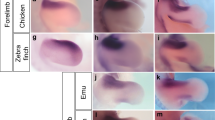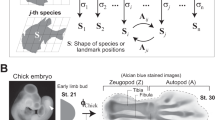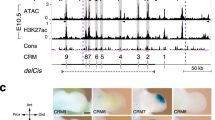Key Points
-
Experiments on the limb buds of chick embryos led to the identification of the polarizing region and the characterization of signalling properties that lead to the morphogen-gradient model.
-
The specification of positional values involves several signalling molecules, such as sonic hedgehog (SHH) and GLI.
-
SHH has been identified as the polarizing-region morphogen, whereas the downstream signalling molecule bone morphogenic protein-2 (BMP2) might only be able to specify positional values in cells already 'primed' by SHH.
-
Sophisticated fate maps in mouse embryos revealed that the length of time that cells are exposed to the highest concentrations of SHH might contribute to digit patterning. This led to a detailed model for specification of positional values for each mouse digit, which integrates both concentration and length of exposure to SHH.
-
Probable candidates for genes that could encode antero–posterior positional values are the homeobox (Hox) genes and orthologues of fruitfly wing-patterning genes.
-
Evidence from studies on chick legs indicates that the morphogenesis of each individual digit involves local interactions. Signalling molecules in digit primordia, such as BMPs and fibroblast growth factors (FGFs), give rise to the final digit morphology.
Abstract
The vertebrate limb has been a premier model for studying pattern formation — a striking digit pattern is formed in human hands, with a thumb forming at one edge and a little finger at the other. Classic embryological studies in different model organisms combined with new sophisticated techniques that integrate gene-expression patterns and cell behaviour have begun to shed light on the mechanisms that control digit patterning, and stimulate re-evaluation of the current models.
This is a preview of subscription content, access via your institution
Access options
Subscribe to this journal
Receive 12 print issues and online access
$189.00 per year
only $15.75 per issue
Buy this article
- Purchase on Springer Link
- Instant access to full article PDF
Prices may be subject to local taxes which are calculated during checkout



Similar content being viewed by others
References
Wolpert, L. Positional information and the spatial pattern of cellular differentiation. J. Theor. Biol. 25, 1–47 (1969).
Wolpert, L. Positional information revisited. Development 107, (Suppl.) 3–12 (1989).
Saunders, J. W. & Gasseling, M. T. in Epithelial–mesenchymal interactions (eds Fleischmeyer, R. & Billingham, R. E.) 78–97 (Williams & Wilkins, Baltimore, USA, 1968).
Tickle, C., Summerbell, D. & Wolpert, L. Positional signalling and specification of digits in chick limb morphogenesis. Nature 254, 199–202 (1975).
Saunders, J. W. in Limb and somite morphogenesis (eds Ede, D. A., Hinchliffe, J. R. & Balls, M.) 1–24 (Cambridge Univ. Press, Cambridge, UK, 1977).
Logan, M. Finger or toe: the molecular basis of limb identity. Development 130, 6401–6410 (2003).
Altabef, M., Clarke, J. D. & Tickle, C. Dorso–ventral ectodermal compartments and origin of apical ectodermal ridge in developing chick limb. Development 124, 4547–4556 (1997).
Martin, G. R. The roles of FGFs in early development of vertebrate limbs. Genes Dev. 12, 1571–1586 (1998).
Tickle, C., Shellswell, G., Crawley, A. & Wolpert, L. Positional signalling by mouse limb polarising region in the chick wing bud. Nature 259, 396–397 (1976).
Honig, L. S. & Summerbell, D. Maps of strength of positional signalling activity in the developing chick wing bud. J. Embryol. Exp. Morphol. 87, 163–174 (1985).
Bowen, J., Hinchliffe, J. R., Horder, T. J. & Reeve, A. M. The fate map of the chick forelimb-bud and its bearing on hypothesized developmental control mechanisms. Anat. Embryol. 179, 269–283 (1989).
Vargesson, N. et al. Cell fate in the chick limb bud and relationship to gene expression. Development 124, 1909–1918 (1997).
Zwilling, E. & Hansborough, L. Interaction between limb bud ectoderm and mesoderm in the chick embryo. III Experiments with polydactylous limbs. J. Exp. Zool. 132, 219–239 (1956).
Cooke, J. & Summerbell, D. Cell cycle and experimental pattern duplication in the chick wing during embryonic development. Nature 287, 697–701 (1980).
Tickle, C., Lee, J. & Eichele, G. A quantitative analysis of the effect of all-trans-retinoic acid on the pattern of chick wing development. Dev. Biol. 109, 82–95 (1985).
Riddle, R. D., Johnson, R. L., Laufer, E. & Tabin, C. Sonic hedgehog mediates the polarizing activity of the ZPA. Cell 75, 1401–1416 (1993).
Niederreither, K., Vermot, J., Schuhbar, B., Chambon, P. & Dolle, P. Embryonic retinoic acid synthesis is required for forelimb growth and antero–posterior patterning in the mouse. Development 129, 3563–3574 (2002).
Mercader, N. et al. Opposing RA and FGF signals control proximodistal vertebrate limb development through regulation of Meis genes. Development 127, 3961–3970 (2000).
Gritli-Linde, A., Lewis, P., McMahon, A. P. & Linde, A. The whereabouts of a morphogen: direct evidence for short- and graded long-range activity of hedgehog signaling peptides. Dev. Biol. 236, 364–386 (2001).
Zeng, X. et al. A freely diffusible form of Sonic hedgehog mediates long-range signalling. Nature 411, 716–720 (2001).
Yang, Y. et al. Relationship between dose, distance and time in Sonic Hedgehog-mediated regulation of anteroposterior polarity in the chick limb. Development 124, 4393–4404 (1997). The effects of SHH application to chick wing buds were characterized in terms of dose and time. The results directly showed the promotion of anterior to posterior positional values.
Chiang, C. et al. Manifestation of the limb prepattern: limb development in the absence of sonic hedgehog function. Dev. Biol. 236, 421–435 (2001).
Hooper, J. E. & Scott, M. P. Communicating with hedgehogs. Nature Rev. Mol. Cell Biol. 6, 306–317 (2005).
Litingtung, Y., Dahn, R. D., Li, Y. N., Fallon, J. F. & Chiang, C. Shh and Gli3 are dispensable for limb skeleton formation but regulate digit number and identity. Nature 418, 979–983 (2002).
Welscher, P. T. et al. Progression of vertebrate limb development through SHH-mediated counteraction of GLI3. Science 298, 827–830 (2002).
Wang, B., Fallon, J. F. & Beachy, P. A. Hedgehog-regulated processing of Gli3 produces an anterior/posterior repressor gradient in the developing vertebrate limb. Cell 100, 423–434 (2000).
Huangfu, D. et al. Hedgehog signalling in the mouse requires intraflagellar transport proteins. Nature 426, 83–87 (2003).
Liu, A., Wang, B. & Niswander, L. A. Mouse intraflagellar transport proteins regulate both the activator and repressor functions of Gli transcription factors. Development 132, 3103–3111 (2005).
Zuniga, A., Haramis, A. P., McMahon, A. P. & Zeller, R. Signal relay by BMP antagonism controls the SHH/FGF4 feedback loop in vertebrate limb buds. Nature 401, 598–602 (1999).
Duprez, D. M., Kostakopoulou, K., Francis-West, P. H., Tickle, C. & Brickell, P. M. Activation of Fgf-4 and HoxD gene expression by BMP-2 expressing cells in the developing chick limb. Development 122, 1821–1828 (1996).
Drossopoulou, G. et al. A model for anteroposterior patterning of the vertebrate limb based on sequential long- and short-range Shh signalling and Bmp signalling. Development 127, 1337–1348 (2000).
Tumpel, S. et al. Regulation of Tbx3 expression by anteroposterior signalling in vertebrate limb development. Dev. Biol. 250, 251–262 (2002).
Coelho, C. N. & Kosher, R. A. A gradient of gap junctional communication along the anterior–posterior axis of the developing chick limb bud. Dev. Biol. 148, 529–535 (1991).
Allen, F., Tickle, C. & Warner, A. The role of gap junctions in patterning of the chick limb bud. Development 108, 623–634 (1990).
Harfe, B. D. et al. Evidence for an expansion-based temporal Shh gradient in specifying vertebrate digit identities. Cell 118, 517–528 (2004). The fate of the cells that express SHH at different stages in mouse limb development was analysed. A model for the specification of mouse digits that integrates both the concentration and the length of exposure to SHH was proposed.
Ahn, S. & Joyner, A. L. Dynamic changes in the response of cells to positive hedgehog signaling during mouse limb patterning. Cell 118, 505–516 (2004). Detailed analysis of the fate of cells that express GLI1 at different stages during mouse limb development in response to SHH showed that cells that respond to SHH at late stages contribute to digits.
Haramis, A. G., Brown, J. M. & Zeller, R. The limb deformity mutation disrupts the SHH/FGF-4 feedback loop and regulation of 5′ HoxD genes during limb pattern formation. Development 121, 4237–4245 (1995).
Michos, O. et al. Gremlin-mediated BMP antagonism induces the epithelial–mesenchymal feedback signaling controlling metanephric kidney and limb organogenesis. Development 131, 3401–3410 (2004).
Shapiro, M. D., Hanken, J. & Rosenthal, N. Developmental basis of evolutionary digit loss in the australian lizard Hemiergis. J. Exp. Zoolog. B Mol. Dev. Evol. 297, 48–56 (2003).
Smith, J. C. Evidence for a positional memory in the development of the chick wing bud. J. Embryol. Exp. Morphol. 52, 105–113 (1979).
Amano, T. & Tamura, K. Region-specific expression of mario reveals pivotal function of the anterior nondigit region on digit formation in chick wing bud. Dev. Dyn. 233, 326–336 (2005).
Welten, M. C. M., Verbeek, F. J., Meijer, A. H. & Richardson, M. K. Gene expression and digit homology in the chicken embryo wing. Evol. Dev. 7, 18–28 (2005).
Summerbell, D., Lewis, J. H. & Wolpert, L. Positional information in chick limb morphogenesis. Nature 244, 492–496 (1973).
Dudley, A. T., Ros, M. A. & Tabin, C. J. A re-examination of proximodistal patterning during vertebrate limb development. Nature 418, 539–544 (2002).
Dolle, P., Izpisua-Belmonte, J.-C., Falkenstein, H., Renucci, A. & Duboule, D. Coordinate expression of the murine Hox-5 complex homeobox-containing genes during limb pattern formation. Nature 342, 767–772 (1989).
Kmita, M., Tarchini, B., Zakany, J., Logan, M., Tabin, C. J. & Duboule, D. Early developmental arrest of mammalian limbs lacking HoxA/HoxD gene function. Nature 435, 1113–1116 (2005).
Izpisua-Belmonte, J. C., Tickle, C., Dolle, P., Wolpert, L. & Duboule, D. Expression of the homeobox Hox-4 genes and the specification of position in chick wing development. Nature 350, 585–589 (1991).
Morgan, B. A., Izpisua-Belmonte, J. C., Duboule, D. & Tabin, C. J. Targeted misexpression of Hox-4.6 in the avian limb bud causes apparent homeotic transformations. Nature 358, 236–239 (1992).
Knezevic, V. et al. Hoxd-12 differentially affects preaxial and postaxial chondrogenic branches in the limb and regulates Sonic hedgehog in a positive feedback loop. Development 124, 4523–4536 (1997).
Zakany, J., Kmita, M. & Duboule, D. A dual role for Hox genes in limb anterior–posterior asymmetry. Science 304, 1669–1672 (2004).
Wellik, D. M. & Capecchi, M. R. Hox10 and Hox11 genes are required to globally pattern the mammalian skeleton. Science 301, 363–367 (2003).
Ingham, P. W. & Fietz, M. J. Quantitative effects of hedgehog and decapentaplegic activity on the patterning of the Drosophila wing. Curr. Biol. 5, 432–440 (1995).
De Celis, J. F. Pattern formation in the Drosophila wing: the development of the veins. Bioessays 25, 443–451 (2003).
Lecuit, T. et al. Two distinct mechanisms for long-range patterning by Decapentaplegic in the Drosophila wing. Nature 381, 387–392 (1996).
Farrell, E. R., Tosh, G., Church, E. & Munsterberg, A. E. Cloning and expression of CSAL2, a new member of the spalt gene family in chick. Mech. Dev. 102, 227–230 (2001).
Zulch, A., Becker, M. B. & Gruss, P. Expression pattern of Irx1 and Irx2 during mouse digit development. Mech. Dev. 106, 159–162 (2001).
Suzuki, T., Takeuchi, J., Koshiba-Takeuchi, K. & Ogura, T. Tbx genes specify posterior digit identity through shh and BMP signaling. Dev. Cell 6, 43–53 (2004).
Rallis, C., Del Buono, J. & Logan, M. P. Tbx3 can alter limb position along the rostrocaudal axis of the developing embryo. Development 132, 1961–1970 (2005).
Bamshad, M. et al. Mutations in human TBX3 alter limb, apocrine, and genetical development in ulnar-mammary syndrome. Nature Genet. 16, 311–316 (1997).
Briscoe, J., Pierani, A., Jessell, T. M. & Ericson, J. A homeodomain protein code specifies progenitor cell identity and neuronal fate in the ventral neural tube. Cell 101, 435–445 (2000).
Dahn, R. D. & Fallon, J. F. Interdigital regulation of digit identity and homeotic transformation by modulated BMP signaling. Science 289, 438–441 (2000). Series of grafting experiments and bead implants showing that morphogenesis of digit primordia is surprisingly plastic.
Sanz-Ezquerro, J. J. & Tickle, C. Fgf signaling controls the number of phalanges and tip formation in developing digits. Curr. Biol. 13, 1830–1836 (2003).
Spitz, F., Gonzalez, F. & Duboule, D. A global control region defines a chromosomal regulatory landscape containing the HoxD cluster. Cell 113, 405–417 (2003).
Smith, J. C. The time required for positional signalling in the chick wing bud. J. Embryol. Exp. Morphol. 60, 321–328 (1980).
Honig, L. S. Positional signal transmission in the developing chick limb. Nature 291, 72–73 (1981).
Tickle, C. The number of polarizing region cells required to specify additional digits in the developing chick wing. Nature 289, 295–298 (1981).
Acknowledgements
I would like to thank M. Fisher and M. Towers for useful discussions, as well as M. Fisher for producing Fig. 2 and A. Bain for producing Fig. 1. I would also like to acknowledge A. Blake for her help with preparing the manuscript and the Medical Research Council and The Royal Society for supporting my research.
Author information
Authors and Affiliations
Glossary
- Mesenchyme
-
A loose meshwork of cells found in vertebrate embryos, which is usually derived from the mesoderm, the middle of the three germ layers.
- Ectoderm
-
The epithelium that is derived from the outer of the three germ layers of the embryo and will give rise to the epidermis of the skin.
- Positional information
-
The instructions that are interpreted by cells to determine their differentiation with respect to their position within the embryo.
- Morphogen
-
A diffusible chemical substance that carries information in embryos, for example, cell position.
- Tbx family
-
Related transcription factors that contain a T-Box.
- Apical ectodermal ridge
-
Thickening of the ectoderm rim at the tip of a developing limb bud in a vertebrate embryo. It is required for bud outgrowth.
- Polarizing activity
-
The ability of cells, tissue or defined chemicals to induce the formation of extra digits from the anterior region of a chick limb bud.
- Fate map
-
A diagram that is obtained experimentally by tracing marked cells and shows the structures that derive from cells in different regions of an embryo.
- Digital plate
-
Broad region that forms late during limb development at the distal end of the bud and contains the digit primordia.
- Humerus
-
The single bone in the upper arm, initially laid down in cartilage.
- Polydactylous
-
Having more than the normal number of digits.
- Intraflagellar transport proteins
-
Proteins that associate with, or in, a flagellum or cilium and the associated basal body.
- Reaction–diffusion mechanism
-
Self-organizing system that consists of two or more interacting chemical substances and spontaneously generates spatial patterns.
- Gap-junctional communication
-
Mechanism of direct cell–cell communication in which small molecules pass through aligned gap junctions on neighbouring cells and not extracellularly.
- β-galactosidase
-
β-Galactosidase is a commonly used reporter molecule, which can be readily visualized.
- Paralogous
-
A sequence, or gene, that originates from a common ancestral sequence, or gene, by a duplication event. For example, as seen in Hoxd gene clusters and designated by a number from 1–13.
- Mammary-ulnar syndrome
-
Rare human congenital condition that is characterized by specific defects in both mammary glands and limbs.
- Haploinsufficiency
-
Defines a genetic condition in which the defect is seen in heterozygous individuals.
- Phalanx
-
(plural phalanges). One of the series of small bones that make up the fingers and toes in vertebrates.
Rights and permissions
About this article
Cite this article
Tickle, C. Making digit patterns in the vertebrate limb. Nat Rev Mol Cell Biol 7, 45–53 (2006). https://doi.org/10.1038/nrm1830
Published:
Issue Date:
DOI: https://doi.org/10.1038/nrm1830
This article is cited by
-
Biased Polyphenism in Polydactylous Cats Carrying a Single Point Mutation: The Hemingway Model for Digit Novelty
Evolutionary Biology (2014)
-
Can we regrow a human arm? A negative perspective from an upper-limb surgeon
Journal of Materials Science: Materials in Medicine (2013)
-
Reaction–Diffusion Systems and External Morphogen Gradients: The Two-Dimensional Case, with an Application to Skeletal Pattern Formation
Bulletin of Mathematical Biology (2012)
-
A regulatory network of two galectins mediates the earliest steps of avian limb skeletal morphogenesis
BMC Developmental Biology (2011)
-
Transcriptomic analysis of avian digits reveals conserved and derived digit identities in birds
Nature (2011)



